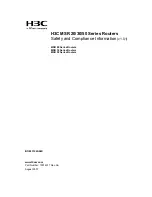
164
Password control configuration
Password control overview
Password control refers to a set of functions provided by the local authentication server to control user
login passwords, super passwords, and user login status based on predefined policies. The rest of this
section describes the password control functions in detail.
1.
Minimum password length
By setting a minimum password length, you can enforce users to use passwords long enough for system
security. If a user specifies a shorter password, the system rejects the setting and prompts the user to re-
specify a password.
2.
Minimum password update interval
This function allows you to set the minimum interval at which users can change their passwords. If a non-
manage level user logs in to change the password but the time that elapses since the last change is less
than this interval, the system denies the request. For example, if you set this interval to 48 hours, a non-
manage level user cannot change the password twice within 48 hours. This prevents users from changing
their passwords frequently.
NOTE:
This function is not effective for users of the manage level. For information about user levels, see the
Fundamentals Configuration Guide
.
This function is not effective for a user who is prompted to change the password at the first login or a user whose
password has just been aged out.
3.
Password aging
Password aging imposes a lifecycle on a user password. After the password aging time expires, the user
needs to change the password.
If a user enters an expired password when logging in, the system displays an error message and prompts
the user to provide a new password and to confirm it by entering it again. The new password must be a
valid one and the user must enter exactly the same password when confirming it.
4.
Early notice on pending password expiration
When a user logs in, the system checks whether the password will expire in a time equal to or less than
the specified period. If so, the system notifies the user of the expiry time and provides a choice for the
user to change the password. If the user provides a new, qualified password, the system records the new
password and the time. If the user chooses to leave the password or the user fails to change it, the system
allows the user to log in using the present password.
NOTE:
Telnet, SSH, and terminal users can change their passwords by themselves. FTP users, on the contrary,
can only have their passwords changed by the administrator.
5.
Login with an expired password
















































